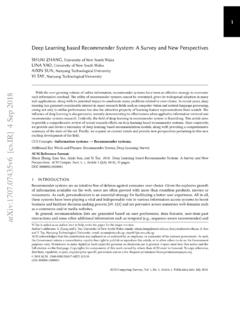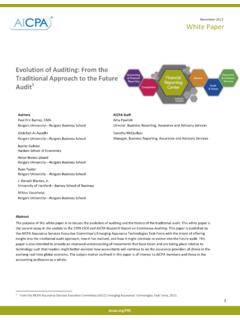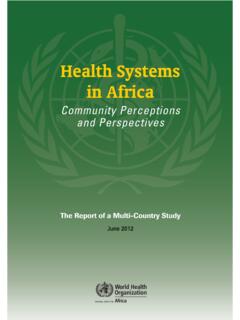Transcription of American Indian Belief Systems and Traditional Practices
1 American Indian Belief Systems and Traditional Practices Betty E. S. Duran, MSW, MPH The University of Oklahoma Cultural Uniqueness of American Indians American Indians today remain the most culturally diverse of the ethnic groups in the United States. Family life, cultural and religious Practices , value Systems , language, and dress vary greatly between American Indian groups that have lived on the same continent for centuries (Drews, et al., 1982). American Indians and Alaska Natives are as racially differentiated as the Europeans and far more diverse culturally and linguistically (Ho, 1987). Historically, American Indians developed societies with well-defined roles, responsibilities, government and economic Systems , recreational and leisure styles, religious rites and ceremonies, social behavior in which group involvement, support and consensus played major roles.
2 Their social, economic and political traditions reflected a strong emphasis on group involvement and decision making (Edwards & Edwards, 1980). American Indian values lean toward a cosmic identity, a harmony of the individual with the tribe, the tribe with the land, and the land with the spirit of the universe. Central to this quest for harmony is a sense of constancy the timelessness and predictability of nature as the foundation of existence. This cycle symbolizes eternity- one reality, and it transcends everything in its absoluteness, giving respect to everything (Herring, 1989). American Indian culture emphasizes harmony with nature, endurance of suffering, respect and non-interference toward others, a strong Belief that man is inherently good and should be respected for his decisions.
3 Such values make individuals and families in difficulty very reluctant to seek help. Their fear and mistrust toward non-Indians caused by past oppression and discrimination make it almost impossible for a non- Indian provider to gain entry into the Indian family system (Ho, 1987). The family is a recognized cornerstone of American Indian society. It serves as a repository for value orientations that guide human behavior, as a transactional milieu for life span socialization, and as a basic catalyst for cultural revitalization (Red Horse, 1980). In Anglo culture there is an expectation of change from generation to generation, whereas, in most Indian cultures there is an expectation that the generations will repeat themselves (Metcalf, 1979).
4 Both American Indian tribal and Christian religions play an important part in the lives of American Indian people. Religion is incorporated into their being from the time of conception, when many tribes perform rites and rituals to ensure the delivery of a healthy baby, to death ceremonies, where great care is taken to promote the return of the person s spirit to the life after this one. American Indians who speak their native language tend to maintain their religious ceremonies, customs, and traditions. They also have more trust in their native people for physical and mental health needs than in Anglo medical doctors or family therapists (Ho, 1987). Indian values are interwoven throughout American Indian culture, lifestyle, religion, an daily activities.
5 Many values are re-enforced through the use of ceremonies (Edwards & Edwards, 1980). Additionally, the values Systems of American Indian groups are as diverse as their lifestyles. However, there are some values that appear to be generic and shared by most American Indian groups. Herring (Herring, 1989) described the following as commonly shared values: Anglo American American Indian Success Happiness Ownership Sharing Number One Tribe and extended family first, before self Youth Oriented Honor your Elders Learning is found in school Learning is through legends Look to the future Look to traditions Work for retirement Work for purpose Be structured & aware of time Time is only relative Oriented to house, job, etc Oriented to land Look ahead, not to the past Cherish the memories of youth A critic is a good analyst Don t criticize your people What are you some kind of animal Live like the animals.
6 They are your bothers and sisters This is America, speak English Cherish your language I ll raise my own; you do the same Children are gift of the Great Spirit to be shared with others The law is the law! Consider the relative nature of a crime, the personality of the individual, and the conditions of the offense. Have a rule for every contingency Few rules are best loose and flexible Religion is for the individual Religion is the universe Understanding Traditional American Indian values and their potentially conflicting opposites in the non- Indian population is a useful point to implementing the objectives of effective social programs that are ostensibly designed to help less-fortunate individuals without interfering with their right to self-determination.
7 It is imperative that service providers learn about the specific Indian tribal groups with which they are working This understanding will facilitate a more successful intervention. Furthermore, service providers should move slowly, identify problems and procedures clearly, make commitments regarding situations in which they have control, follow through consistently, and use client strength appropriately in order to develop a feeling of trust and establish professional relationships. Additionally, in working with an American Indian client, the service providers should assure an appropriate authoritarian position that permits the client to assume as much responsibility as possible for his or her activities, discussion, and decision making.
8 Strengths of Cultural Intervention for American Indian Tribal ritual and ceremonial Practices provide a code for ethical behavior and social organization which contribute to a meaning of life. It also provides a means for intervening in individual or social dysfunction. American Indians are caught between two cultures, attempting to preserve the best of the old, while adopting the best and necessary of the new. Though there has been significant progress in the control of biomedical oriented pathologies, there still exists a high rate of death attributed to the stress of biculturalism. Much of this high death rate is due to accidents, suicides, substance abuse, and violence.
9 Expressions of the emotional stress experienced by individuals who have been stripped of their cultural traditions and forced to live a bicultural existence (Guilmet & Whited, 1987). Racism and oppression, including internalized oppression, are continuous forces which exacerbate these destructive behaviors (Brave Heart & DeBruyn, 1998). The chronic depression displayed by many American Indian people can be linked with such factors as failing to acquire upward mobility in American society, subjective feelings of rejection and discrimination, guilt stemming from collective and personal denial of their heritage, and moral disorientation due to the fragmentation of Traditional Practices .
10 Guilmet and Whited (1987) report that an increasing body of psychiatric literature suggests that the integration of Indian healing Practices along with western treatment strategies can have a positive impact on Indian depression. Cultural interventions include ceremonies of name giving, spiritual cleansing of individuals, as well as homes and offices, and education on tribal traditions and Practices . Strengthening of ethnic identity results from participation in tribal community activities, tribal language classes, Traditional American Indian arts and crafts, and teaching of Traditional rewards and values as compared with western society. Tribal members who do not adhere to cultural rules and functions tend to feel isolated, struggle with identity, and may act out frustrations by using alcohol or engaging in other kinds of destructive behavior.







